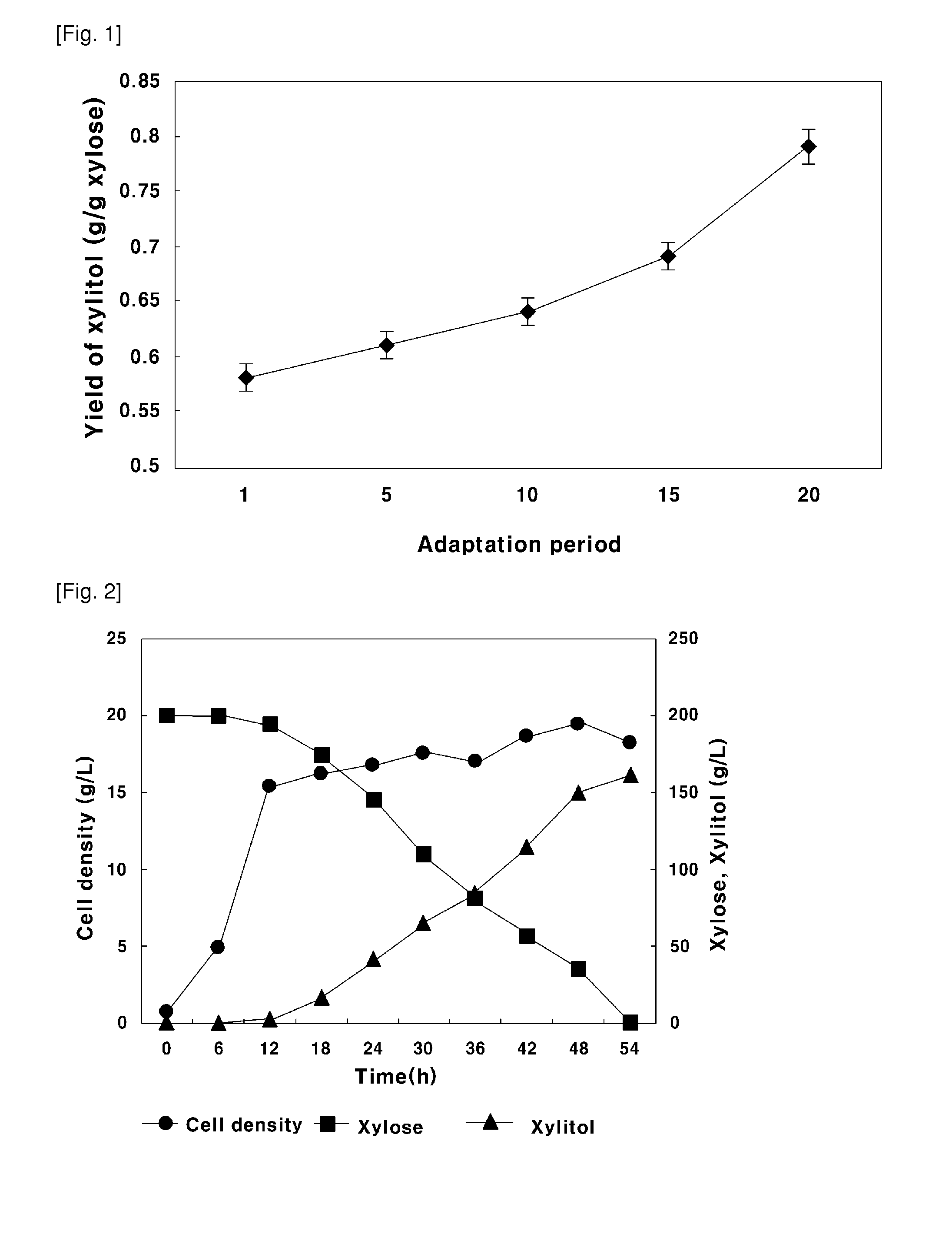Method of Producing Xylitol Using Hydrolysate Containing Xylose and Arabinose Prepared from Byproduct of Tropical Fruit Biomass
a technology of hydrolysate and xylose, which is applied in the field of producing xylitol using a hydrolysate containing xylose and arabinose prepared from a byproduct of a tropical fruit biomass, can solve the problems of difficult separation and purification of xylitol or xylose, risks of undergoing a reaction at high temperature and high pressure using alkali and waste, and achieve the effect of efficient use of effective ingredients
- Summary
- Abstract
- Description
- Claims
- Application Information
AI Technical Summary
Benefits of technology
Problems solved by technology
Method used
Image
Examples
example 1
Preparation of Xylose and Arabinose
[0050]Coconut shell, palm shell and OPEFB, the byproducts of tropical fruit biomass, were pulverized into 0.5˜5 cm2 in average area or 0.1˜5 cm in average length, and dried at 40˜80° C. for 12˜24 hours.
[0051]Acid-hydrolysis was performed by the following steps; 100˜1,000 g of 0.2˜5.0% sulfuric acid solution was added to 100 g of the dried coconut shell, palm shell or OPEFB to make a mixture of the biomass and a solvent for acid-hydrolysis at the ratio of 1:1˜1:20; and the mixture was reacted by stirring at 100˜200° C., 10˜50 rpm under the reaction pressure of 0˜10 kgf / cm2 for 0.5˜10 hours. Sugar compositions according to the extraction time are shown in Table 1.
TABLE 1Sugar compositions according to extraction time (%)Coconut shellPalm shellOPEFBGluXylAraGalGluXylAraGalGluXylAraGal0.5 hr 6.487.75.9—8.888.32.9—6.788.84.5—1 hr5.689.54.9—7.489.23.4—5.987.35.81.03 hr7.985.65.51.011.983.14.10.97.983.27.41.56 hr20.171.66.81.518.474.85.61.219.670.78.41.3...
example 2
Preparation of Xylose and Arabinose
Using Different Hydrolase
[0056]An experiment was performed by the same manner as described in example 1 except that the acid treatment was performed with 0.2-5.0% HCl solution instead of 0.2 5.0% sulfuric acid solution. The yields and purity of the obtained xylose and arabinose are shown in Table 3.
example 3
Preparation of Xylose and Arabinose
Using Different Hydrolase
[0057]An experiment was performed by the same manner as described in example 1 except that the acid treatment was performed with 0.2-5.0% oxalic acid solution instead of 0.2-5.0% sulfuric acid solution. The yields and purity of the obtained xylose and arabinose are shown in Table 3.
PUM
| Property | Measurement | Unit |
|---|---|---|
| temperature | aaaaa | aaaaa |
| length | aaaaa | aaaaa |
| conductivity | aaaaa | aaaaa |
Abstract
Description
Claims
Application Information
 Login to View More
Login to View More - R&D
- Intellectual Property
- Life Sciences
- Materials
- Tech Scout
- Unparalleled Data Quality
- Higher Quality Content
- 60% Fewer Hallucinations
Browse by: Latest US Patents, China's latest patents, Technical Efficacy Thesaurus, Application Domain, Technology Topic, Popular Technical Reports.
© 2025 PatSnap. All rights reserved.Legal|Privacy policy|Modern Slavery Act Transparency Statement|Sitemap|About US| Contact US: help@patsnap.com



